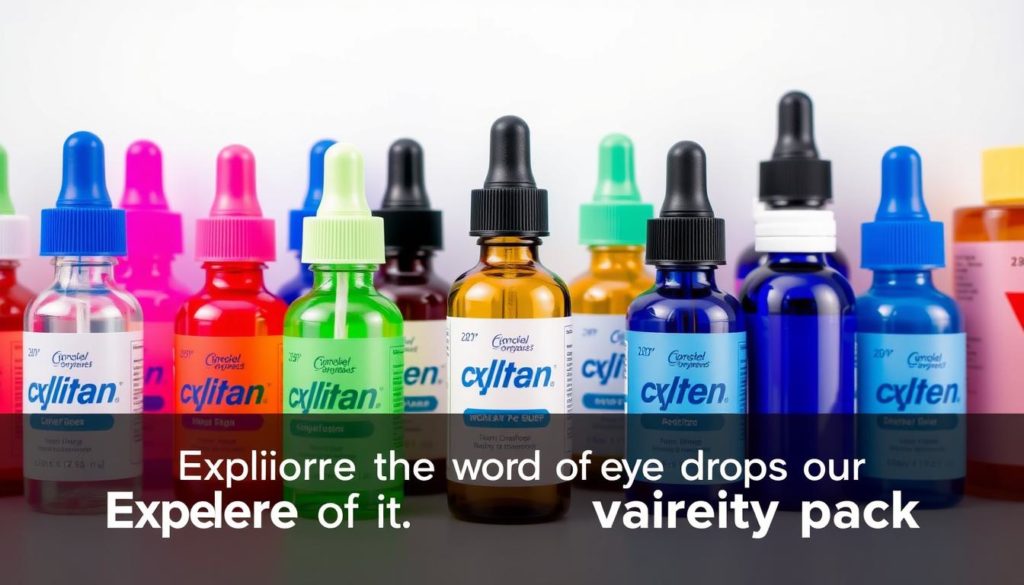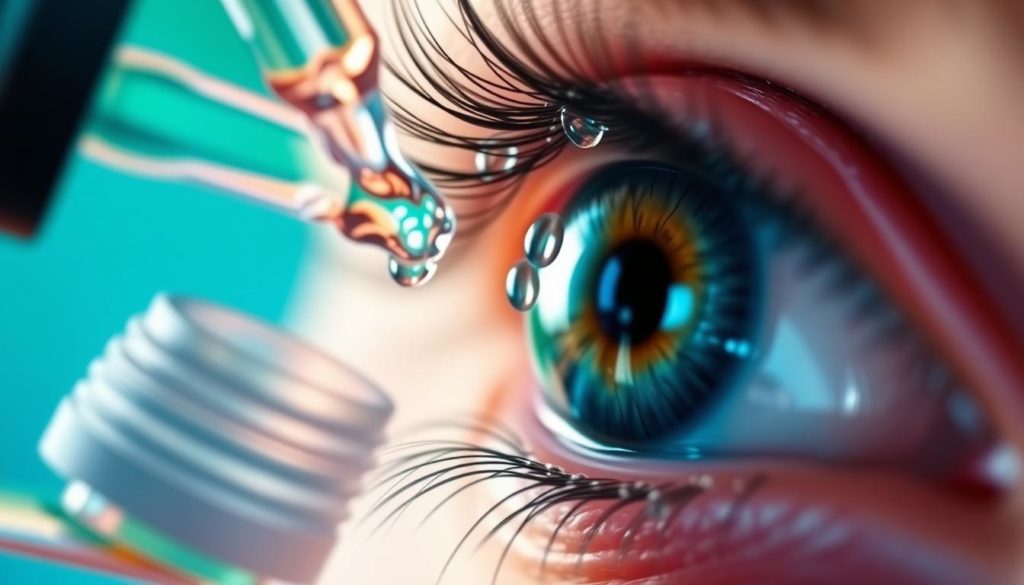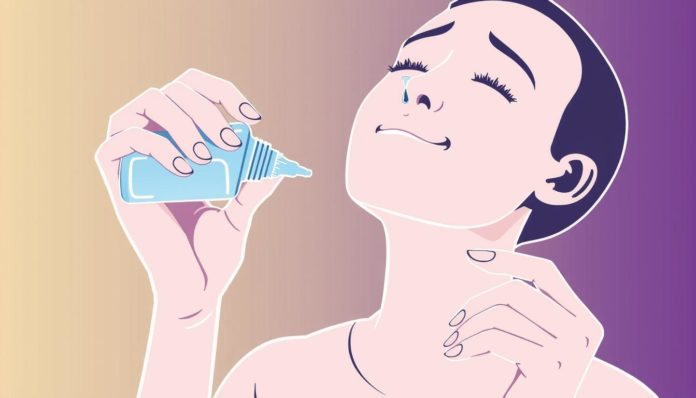Did you know that nearly 48% of Americans suffer from eye discomfort? This includes dryness and irritation. Many people don’t know how to use eye drops right to help with these problems. It’s important to learn the right way to use eye drops to get relief and make the medicine work better.
Using eye drops correctly is more than just dropping one into your eye. You need clean hands, the right supplies, and a step-by-step method. This helps avoid contamination and makes sure you get the right amount. By learning how to apply eye drops correctly, you can keep your eyes healthy and feel better every day.
Understanding Eye Drops: What You Need to Know
Eye drops are key in eye care, helping with various conditions and making eyes more comfortable. It’s important to know about the different types and how to use them right. This knowledge ensures they work best and give good results.

Types of Eye Drops
There are many eye drop types for different needs. These include:
- Lubricating drops for dry eyes
- Anti-redness drops to reduce bloodshot eyes
- Antihistamine drops for allergy relief
- Antibiotic drops for infections
Knowing which drop is right for your issue can make eye care more effective.
Why Proper Technique Matters
Using the right way to put in eye drops is key for their best use. This means putting them in correctly, handling different types, and keeping them clean. Also, spreading out doses for multiple medications helps avoid bad reactions and makes them work better.
Doing eye care right with the right technique cuts down on waste and side effects. This leads to better eye health outcomes.
Benefits of Using Eye Drops for Eye Health
Eye drops are key to better eye health. They help with dryness, irritation, or redness. Using them can make your eyes feel more comfortable and healthy.

Alleviating Dryness
Eye drops are great for alleviating eye dryness. Dry eyes can make you feel uncomfortable and blurry. Regular use of moisturizing drops keeps your eyes well-hydrated. If you have sensitive eyes, look for drops without preservatives.
Reducing Redness and Irritation
Eye drops also help reduce eye irritation and redness. Things like pollen, dust, and too much screen time can cause these problems. Using the right drops can calm your eyes and keep them safe from more irritation. This helps keep your eyes in top shape.
Preparing to Use Eye Drops: Essential Steps to Follow
Getting ready for eye drops is key to keeping your eyes healthy. It’s important to follow a specific eye health protocol. This makes sure the process is safe and works well.
Gather Your Supplies
Start by making sure you have everything you need. You’ll need the eye drop bottle, a clean tissue, and maybe a mirror. Having these items ready makes the process easier and helps you stick to the eye health protocol.
Washing Your Hands Properly
Keeping your hands clean is vital for safely using eye drops. First, wash your hands with soap and water for at least 20 seconds. If soap and water aren’t around, use a hand sanitizer with at least 60% alcohol.
This hand hygiene step stops germs from getting into the eye drop bottle or your eyes. It’s a key part of your eye health routine. It helps avoid infections and makes sure the treatment works.
| Steps | Details |
|---|---|
| Gather Supplies | Eye drop bottle, tissue, mirror |
| Wash Hands | Use soap and water or hand sanitizer |
How to Use Eye Drops
Using eye drops correctly is key to keeping your eyes healthy and treating them effectively. Start by making a clean area to prevent infections. Always follow the eye drop instructions on the package or from your doctor.
First, wash your hands well. Then, tilt your head back or lie down to make sure you can put the drops in right. This helps you put the drops exactly where they need to go.
With one hand, pull down your lower eyelid to make a small pocket. Hold the eye drop bottle with your other hand, making sure not to touch it to your eye or anything else. Drop the right number of drops into the pocket.
After putting in the eye drops, close your eye and press on the inner corner. This stops the drops from going into your tear duct. It lets the drops work by being absorbed by your eye.
Getting good at using eye drops takes practice and patience. By learning the right way to do it, you make sure your eyes get the most out of the medicine.
Step-by-Step Guide: Administering Eye Drops Correctly
Managing your eye health means using eye drops the right way. Follow this eye drop guide to make sure you’re doing it right.
Tilt Your Head and Form a Pouch
Begin by tilting your head back a bit. Then, use your index finger to gently pull down your lower eyelid. This makes a small pouch, making administering eye drops easier and more accurate.
Applying the Drop
Hold the dropper right above your eye and squeeze out one drop into the pouch. Don’t touch the dropper tip to your eye or any other surface. This keeps the eye medication protocol clean, avoiding contamination and infections.
Giving the Medication Time to Work
After putting in the drop, close your eye without blinking too much. Press the corner of your eye near the nose to keep the drops from going into your nose. Let the medicine work by keeping your eye closed for a minute or two.
Handling Multiple Types of Eye Drops
If you’re using more than one type of eye drop, timing is key. Wait at least five minutes before adding another drop. This lets each medicine absorb fully and prevents them from mixing together.
Common Mistakes to Avoid When Using Eye Drops
Using eye drops correctly is more than just dropping a drop into your eye. It seems simple, but there are common mistakes that can make your treatment less effective.
Touching the Dropper to the Eye
One big mistake is touching the dropper tip to your eye or eyelashes. This can put bacteria into the bottle, raising the risk of infection. Always keep the dropper away from your eye to keep it clean.
Not Waiting Between Drops
Not waiting long enough between eye drops is another common mistake. If you use different eye drops, wait at least five minutes between each one. This helps make sure each drop works as it should. Remember, waiting is important to avoid eye drop mistakes.
By avoiding these eye drop application errors, your treatment will be safe and effective. Take a moment to check your technique to keep your eyes healthy and comfortable.
Do’s and Don’ts of Eye Drop Application
Using eye drops correctly can greatly improve eye health and ease discomfort. By following some key eye drop dos and don’ts, you can get the most out of your medication. This also helps avoid potential problems.
Do’s
Here are important steps to follow when using eye drops for safe and effective use:
- Use within recommended time frames: Always use the drops as directed, and don’t use them longer than advised by a doctor.
- Follow specific orders for different medications: If you have multiple drops, use them in the order your healthcare provider recommends for best results.
- Expect overflow: It’s normal if you see a bit of excess liquid. Just use a clean tissue to gently blot it away.
Don’ts
It’s also crucial to avoid certain actions to prevent complications with eye drops:
- Prevent dropper contamination: Make sure the dropper tip doesn’t touch your eye, hands, or any surface to avoid contamination.
- Avoid using contact lenses with medicated drops: Unless your doctor says it’s okay, take out your contact lenses before applying drops to avoid issues.
- Never share eye drops: Sharing eye drops can spread infections and other problems, so always use your own drops.
| Do’s | Don’ts |
|---|---|
| Use within recommended time frames | Prevent dropper contamination |
| Follow specific orders for different medications | Avoid using contact lenses with medicated drops |
| Expect overflow | Never share eye drops |
Following these tips for applying eye drops can keep your eyes healthy and free from complications. Always talk to a healthcare professional if you have questions or concerns about your eye drop use.
Special Tips for Using Eye Drops on Children
When giving eye drops to kids, making the space calm and comforting is key. These tips can make the process easier for kids.
Creating a Calm Environment
Kids might feel scared of eye drops, so a peaceful setting is important. Being gentle and patient helps a lot. Use a soft voice, explain it simply, and look into their eyes to make them feel safe and willing to cooperate.
Alternate Application Methods
For kids, you might need to try different ways to give eye drops. One good way is to have the child lie down with their eyes shut. Then, put the drops in the inner corner of their eye. When they open their eyes, the drops will go in easily. Using special devices for kids can also make it less scary and easier.
Caring for Your Eye Drop Bottle
Proper eye drop bottle care is key to keeping your eye medication safe and effective. A big part of this is taking good care of where you store your eye drops.
- Always keep the dropper tip clean and free from contaminants. This prevents infection and contamination of the solution.
- Store your eye drop bottle as per the instructions provided by the manufacturer. Some may require refrigeration, while others need to be kept at room temperature.
- Be vigilant about checking expiration dates. Using expired drops can be unsafe and less effective.
Managing your eye drop supplies well keeps them clean and effective. Here’s a handy reference:
| Aspect | Details |
|---|---|
| Cleaning | Ensure dropper tip is uncontaminated. |
| Storage | Follow manufacturer’s guidelines (refrigerated or room temperature). |
| Expiration | Check dates regularly. |
Alternative Methods for Applying Eye Drops
For some, putting in eye drops can be hard. It might be because of discomfort, trouble with precision, or not being able to move your hands well. Luckily, there are other ways to put in eye drops that can make things easier.
Lying Down Technique
If you’re having trouble with the usual way, try lying down. Sit on a bed or sofa with your head flat and look up at the ceiling. Pull down your lower eyelid to make a pocket. Then, put the drops in this pocket without worrying about them falling out.
This method is great for people who can’t keep their eyes still or open during the process.
Using Eye Drop Assistance Devices
Eye drop aids can make putting in eye drops easier and more precise. They often have a steady grip or aim that helps put the drops right in your eye. These tools are perfect for people with arthritis, shaking, or who don’t like handling eye drops.
Look into brands like Autodrop or Droptainer for these helpful devices.
FAQ
What are the different types of eye drops?
There are many types of eye drops, each for different needs like dry eyes, redness, allergies, or infections. It’s key to pick the right one for your eyes.
Why is proper technique important when using eye drops?
Using eye drops right makes sure they work best and cuts down on side effects. It also keeps the medicine safe and makes sure you get the right amount.
How do eye drops benefit eye health?
Eye drops help with dryness, reduce redness and irritation, and make eyes feel better. They keep the eyes healthy and prevent serious problems from dryness and irritation.
What do I need to prepare before using eye drops?
Get your eye drop bottle and a tissue ready. Make sure your hands are clean with soap and water or sanitizer to avoid infection.
How should I position my head when using eye drops?
Tilt your head back and pull down your lower eyelid to make a pouch. This way, the drop goes right into your eye without spilling.
What are some common mistakes to avoid when using eye drops?
Don’t touch the dropper tip to your eye or nearby skin to keep it clean. Also, wait the right amount of time between different drops to keep them working well.
What are the dos and don’ts of eye drop application?
Do follow the recommended times, use drops in the right order, and accept some spill as normal. Keep the dropper clean. Don’t share drops, touch the dropper, or mix with contact lenses unless a doctor says it’s okay.
How can I make it easier to administer eye drops to children?
Make the area calm to lessen stress, try different ways to apply drops, and reassure your child gently. Using special devices can also help make it easier.
How should I care for my eye drop bottle?
Keep the dropper clean, store it as the label says, and check the expiration date. Taking good care of it keeps the medicine safe and effective.
Are there alternative methods for applying eye drops?
Yes, you can try lying down or use special devices for better aim. These can help if traditional methods are hard for you.


